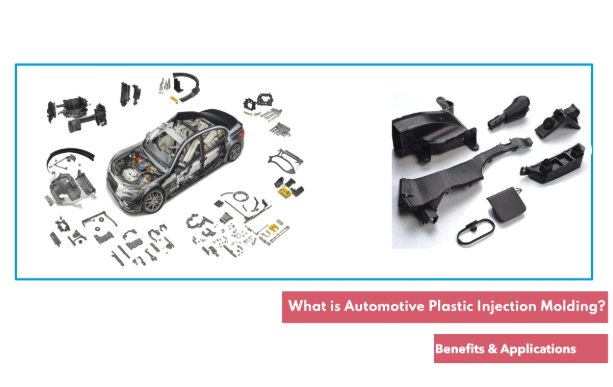Today a lot of your car parts are made with high-performance plastics, ABS, polycarbonate, Polypropylene, and PVC. Do you know how they are trampled into fishised auto parts ready for assembly? Well, most of the time, Automotive Plastic Injection Molding is used. Not only cars, trucks, buses, jeeps, motorbikes, and even military vehicles use injection molding parts.
In this article, we will focus on how and which plastic injection molding automotive parts are made, especially Acrylonitrile Butadiene Styrene (ABS).
Which Plastics Are Used in Automotive Plastic Injection Molding?
Automotive parts of different materials
Typically, thermoplastic materials are used in automotive injection molding. Moreover, high-performance plastic, in both strength and durability, like PP, PVC, and ABS injection molding are the most common.
Acrylonitrile Butadiene Styrene (ABS)
The ABS injection molding process is more popular in automotive than any other thermoplastics. Its rigidity, mechanical strength, toughness, impact resistance, and lightweight properties make it suitable to make various automotive parts.
Another thing is its flowability in the liquid phase; ABS can be molded into complex shapes with high accuracy. Consequently, parts made with ABS injection molding also offer a good aesthetic.
Polypropylene(PP)
PP is a high-strength material with excellent chemical resistance, thermal stability, fatigue resistance, and flexibility. Automotive parts like bumpers, trims, and underhood components are made with Polypropylene injection molding.
Polyamide(Nylon)
Nylon is another common plastic used in automotive industries; it can withstand high thermal and mechanical stress. Nylon is also good for parts requiring high tensile strength and toughness, like bushings.
Polyvinyl Chloride (PVC)
Mainly, automotive interiors and rigid structural items are made with PVC molding. PVC’s excellent abrasion resistance, insulating properties, and hardness customization benefits make it suitable for these applications.
Other Plastics
Besides the above four plastics, other materials are also used in automotive die casting: Polyurethane (PUR), Polycarbonate(PC), etc.
Automotive Injection Molding Process
- Mold Desing and Machining
- Material Preparation and Melting
- Injection into Die Cavity of Mold made for Auto Part
- Solidification
- Mold Opening and Part Ejection
- Post-processing/Surface Finish
The main difference between the automotive injection molding process and standard molding is precision and strict quality control procedures.
Injection mold for auto part
It starts with mold design based on which auto parts you want to make. Muti-axis CNC machining, EDM, and other accurate processes are used for mold creation. Then, injection variables like pressure, flow, and temperatures are precisely controlled.
After ejecting the parts, post-processing and finishing are done based on requirements. Typically, plastic injection molding automotive parts involve a roughness range as low as 0.02µm
Benefits of Injection Molding in the Automotive Industry
Using injection molding to manufacture automotive parts provides lightweight and durable parts at competitive prices. Reducing the weight helps to improve vehicle performance.
Fast Production Speed
A single mold tooling setup can produce several batches without machine downtime. Additionally, production cycle time is also low for molding compared to other manufacturing processes.
High Volume Production and Low Cost
Once you make the mold with durable material like tool steel, it can be used to produce numerous identical parts( up to a million in some cases). It reduces the per/part production cost.
Smooth Surace Finish
Based on the details of cavity finish, matte, smooth, glossy, and other finishing options can be achieved on plastic injection molding automotive parts. Additionally, different color options are available.
Material Versatility
As discussed previously, different plastics can be processed with injection molding for vehicle components. It allows to production of custom parts fulfilling desired performance requirements.
Tight Precision
You can get automotive parts tolerances as tight as ±0.05mm, which facilitates straightforward assembly. The molding process produces a minimal number of defective parts.
Durability of Parts
Plastics are rust-free, chemical, and environment-resistant materials, whereas molding keeps these original properties unchanged after converting them into the desired shape. They last for longer spans, up to 20 years or more.
Examples of Plastic Injection Molding Automotive Parts
Automotive plastic molding part
Let’s take a look at what kinds of automotive parts are made with the injection molding process;
- Interior Components: Dashboards, door handles, cup holders, seat trims, and air vents.
- Exterior Part: Bumpers, grilles, headlight lenses, fender liners, etc.
- Engine & Cooling: Intake manifolds, valve covers, fuel pump housing, radiator tanks, fan shrouds, and oil caps
- Electrical System: Battery cases, fuse boxes, connectors, sensor housings, and relay enclosures.
- HVAC: Air ducts, climate panels, blower housings, defroster vents, etc.
- Others: Cargo bins, roof racks, sunroof components, etc.
Conclusion
Injection molding can be used for various automotive parts, from interior components to functional items. ABS, nylon, PVC, PC, PP, and other thermoplastics are commonly used to make auto parts. However, the choice of the right plastic and quality of mold tooling significantly impact the final result, including precision and finish.
